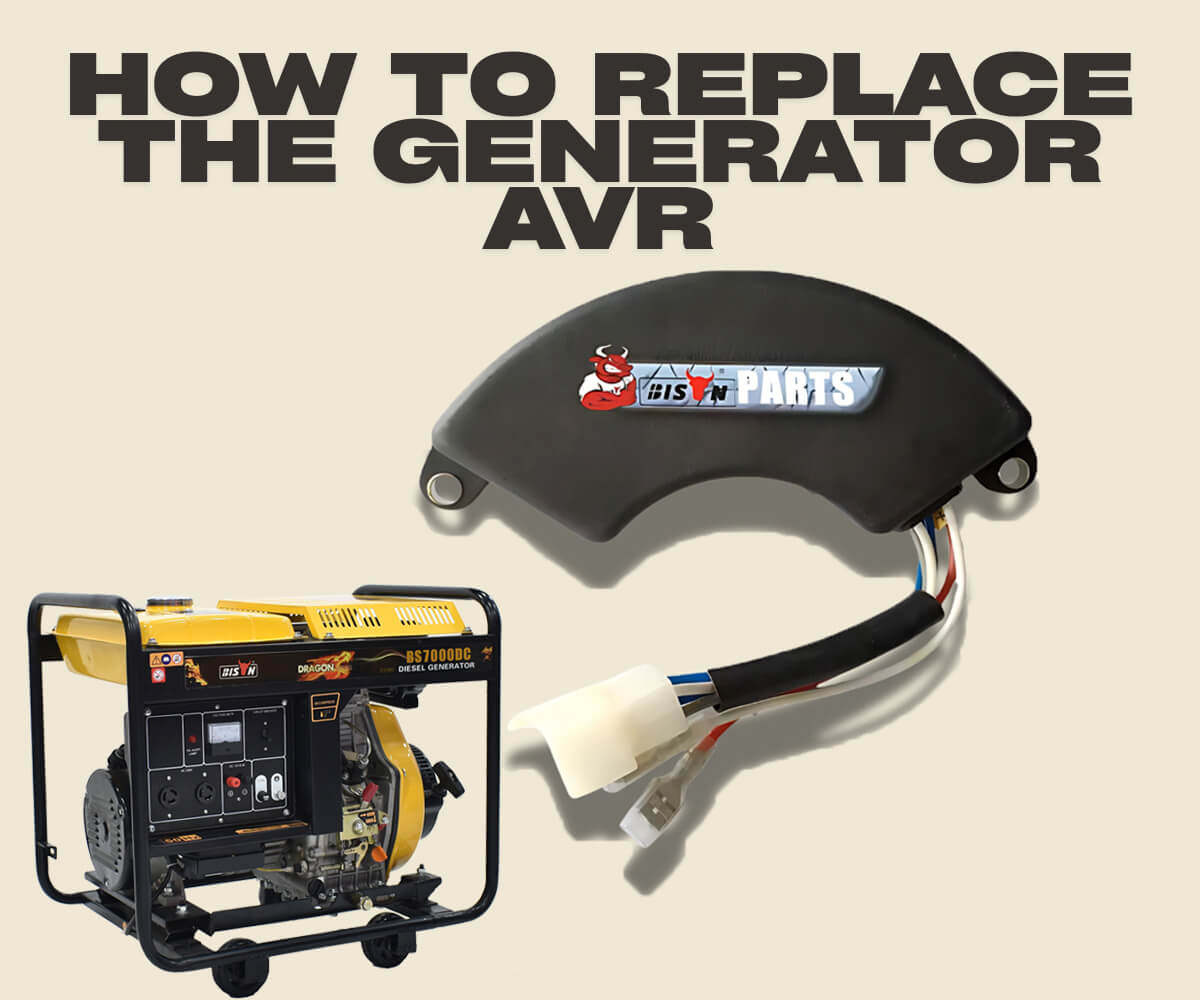How to replace the generator AVR
- BY BISON
Table of Contents
An automatic voltage regulator (AVR) is a key generator component that ensures stable voltage output by automatically controlling the electrical system. It keeps the voltage within a safe range, protecting the generator and connected appliances from sudden surges or drops. When an AVR starts to fail, you may notice fluctuating voltage, no output, or engine overspeed — all of which can cause serious problems. Ignoring these signs can lead to long-term damage, making prompt replacement essential for safe and reliable performance.
Understanding the AVR’s role, recognizing signs of failure, and knowing when to replace it are vital for maintaining a generator’s efficiency and lifespan. Timely AVR maintenance prevents breakdowns, extends generator life, and supports efficient energy use. This blog will guide you on how to check and when to replace your AVR.

Understanding the automatic voltage regulator (AVR) and its role in generators
As an important component of the generator, the automatic voltage regulator (AVR) maintains a stable voltage output even when the load or engine speed changes. Without it, voltage spikes or drops could damage sensitive electronics, reduce efficiency, and shorten the generator’s lifespan.
By regulating the output voltage, the AVR stabilizes power, reduces fluctuations, and helps prevent breakdowns, resulting in lower maintenance costs and longer service life. This stability also supports energy efficiency and aligns with sustainable operation goals by lowering energy waste and carbon footprint.
How an AVR works?
The AVR operates by detecting and correcting voltage fluctuations. A potential transformer measures the generator’s output voltage, which is then rectified, filtered, and compared to a set reference value. If a difference is detected, the AVR adjusts the generator’s excitation to bring the voltage back to the correct level. In parallel generator setups, the AVR can also help share loads evenly, improving system stability and performance under varying demand.
Preparing to replace a generator’s AVR
Before replacing the automatic voltage regulator (AVR), turn off the generator and disconnect it from any power source. If it has been running, let it cool completely to avoid burns. Wear protective gloves and safety glasses since you’ll be working near electrical components.
You’ll need a few basic tools: flathead and phillips screwdrivers, a multimeter for testing, pliers, a wrench (if required for your model), and possibly wire cutters/strippers. Keep your generator’s manual and wiring diagram handy, as they will guide you through the correct connections and help prevent mistakes.
Before purchasing a new AVR, ensure it’s compatible with your generator by checking the model number, voltage rating, and specifications on the old unit or in the manual.
Set up a safe workspace on a clean, flat surface with good lighting. Keep all tools, the new AVR, and the manual within easy reach to make the process smooth and efficient. Proper preparation ensures a safer and quicker replacement.
Step-by-step guide to replacing a generator’s AVR
Step 1. Locate the AVR
The AVR is usually near the generator’s control panel or alternator and appears as a small rectangular or square module connected by several wires. Check your generator’s manual for the exact location and refer to any diagrams for easier identification.
Step 2. Turn off and disconnect the power
Shut down the generator and disconnect it from all power sources and loads. If it was recently running, allow it to cool completely before starting work.
Step 3. Document the wiring
Before removing any wires, label each one or take clear photos of the connections. This ensures correct reconnection later and helps prevent mistakes.
Step 4. Disconnect the wires
Using a screwdriver or pliers, carefully loosen and disconnect the wires from the AVR. Avoid damaging connectors and keep track of your labels.
Step 5. Remove the old AVR
Unscrew or unclip the AVR from its mounting bracket, keeping all screws or hardware in a safe place for reuse.
Step 6. Install the new AVR
Position the new AVR in place and secure it with the original screws or clips. Make sure it is properly aligned and stable.
Step 7. Reconnect the wires
Using your labels or reference photos, attach each wire to the correct terminal on the new AVR. Tighten connections securely without over-tightening.
Step 8. Double-check everything
Verify that all wires are connected correctly and securely, matching the original layout, before powering on the generator. This will prevent electrical faults when the generator is powered back on.

Testing the generator after installing a new AVR
Reconnect the generator to its power source and start it according to your manual, keeping a safe distance from moving parts while it’s running.
Use a multimeter set to the correct AC voltage range, and connect the probes to the output terminals or an outlet on the generator. Compare the reading to the voltage range specified in your manual. A stable reading within range means the AVR is regulating voltage correctly.
For a final check, perform a simple load test by plugging in a low-power device, such as a light bulb or small appliance. If it operates smoothly without flickering or fluctuations, your new AVR is functioning properly.
Symptoms of AVR failure in diesel generators
Voltage fluctuations, system resets, unusual noises, unexpected shutdowns or restarts, or visible wear and damage to the unit may indicate the need to replace the automatic voltage regulator (AVR).
Here are the steps recommended by BISON to check AVR:
- Monitor the generator’s power output for instability or voltage deviations.
- Listen for abnormal noises that may indicate internal AVR problems.
- Watch for unexpected shutdowns or restarts, which often point to AVR faults.
- Inspect the AVR for physical wear, cracks, or burns.
- Review the generator’s diagnostic system for any AVR-related error codes or alerts.
For more AVR fault information, please refer to “Causes of damaged voltage regulator (AVR)“.
Troubleshooting common problems after replacing a generator’s AVR
No voltage output: Incorrect connections are the most common cause. Compare your wiring with the photos or labels you made during removal and the diagram in the manual. If wiring is correct but there’s still no output, the AVR may be defective, or another component, such as the alternator, may require service.
Fluctuating voltage: Unstable voltage often results from loose connections. Ensure all wires are firmly secured. On digital avrs, incorrect settings can also cause fluctuations, so check and adjust them according to the manual.
Engine overspeed: If the engine runs faster than normal, shut down the generator immediately. Overspeed can cause severe damage and is unsafe to operate. This may indicate an incompatible AVR or a deeper mechanical issue. Contact a qualified technician for proper diagnosis and repair.
Conclusion
Understanding the AVR’s role in diesel generators helps you identify early signs of trouble—such as power fluctuations, frequent trips, or stalling—and take action before small issues become costly failures. Proactive maintenance and timely replacement keep your generator running smoothly and extend its service life.
A well-functioning BISON AVR safeguards both your generator and connected equipment, reducing downtime and repair costs. While many replacements can be done with basic tools and proper guidance, it’s always best to consult a qualified technician if you’re unsure about wiring or encounter unusual problems like engine overspeed.
As a professional diesel generator and generator parts manufacturer in China, BISON offers high-quality AVRs designed for durability, precision, and consistent performance. Backed by the comprehensive service of the BISON factory, we provide full support—from product guidance to after-sales solutions—to help our partners succeed. Dealers are welcome to start business with BISON today and supply customers with dependable generators and premium AVR replacements that stand the test of time.
FAQs
How long does it take to replace a generator’s AVR?
The time required depends on the complexity of the generator, the availability of the correct AVR, and the installer’s expertise. For most models, an experienced technician can complete the replacement within 30–60 minutes, while less familiar users may take longer.
How can I identify my generator’s AVR model?
Check your generator’s manual or inspect the AVR, usually located near the alternator. Most AVRs have a label showing the model number, voltage range, and other specifications. If the label is missing or unreadable, contact the manufacturer or supplier with your generator’s make and model to confirm the correct part. Keeping accurate details ensures you purchase a compatible AVR for safe and effective operation.
What is fault voltage in a generator?
Fault voltage is the difference between the actual voltage output and the reference voltage. This error is sent to the amplifier, which increases the signal and passes it to the exciter. The exciter then adjusts the alternator’s output to correct voltage fluctuations and maintain stable power.
contact us
related product categories
Get in touch to speak with our experts!








